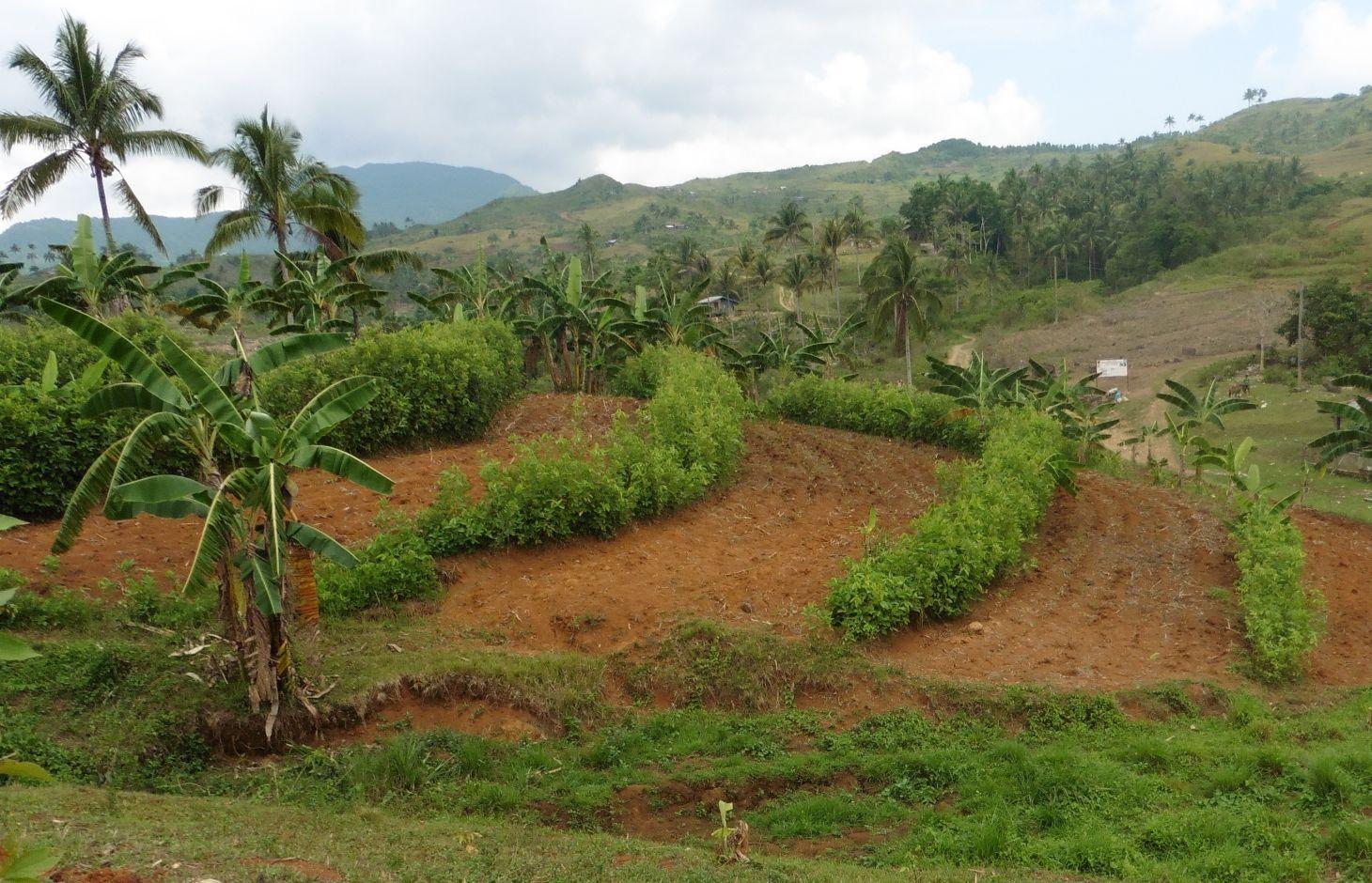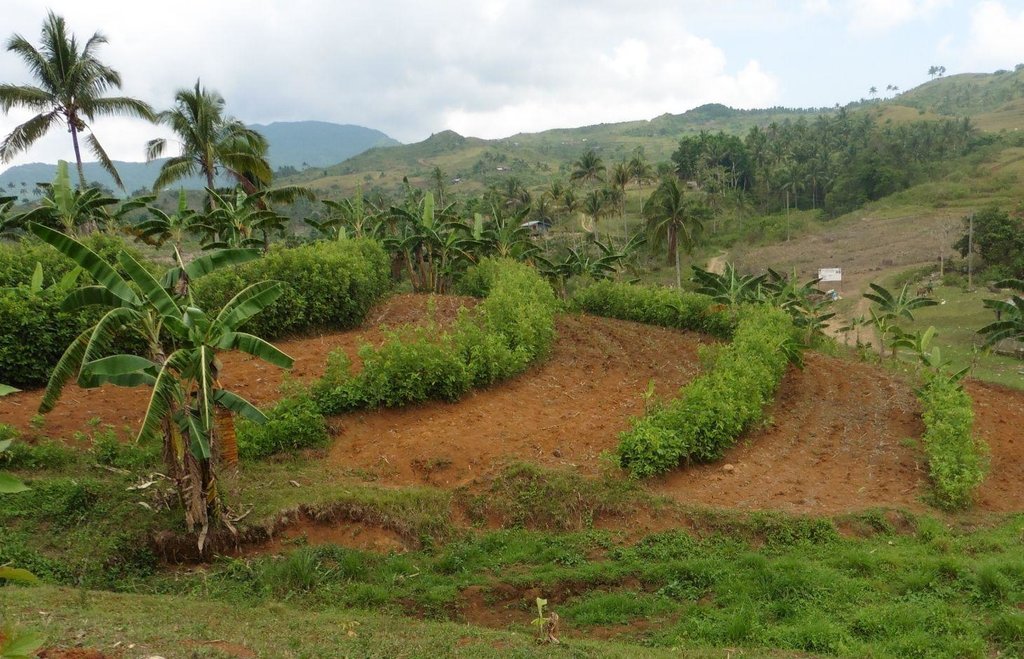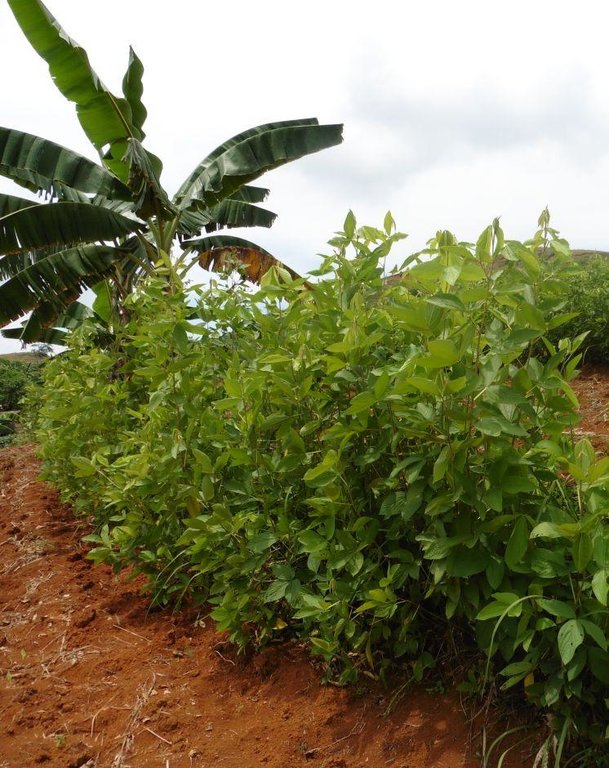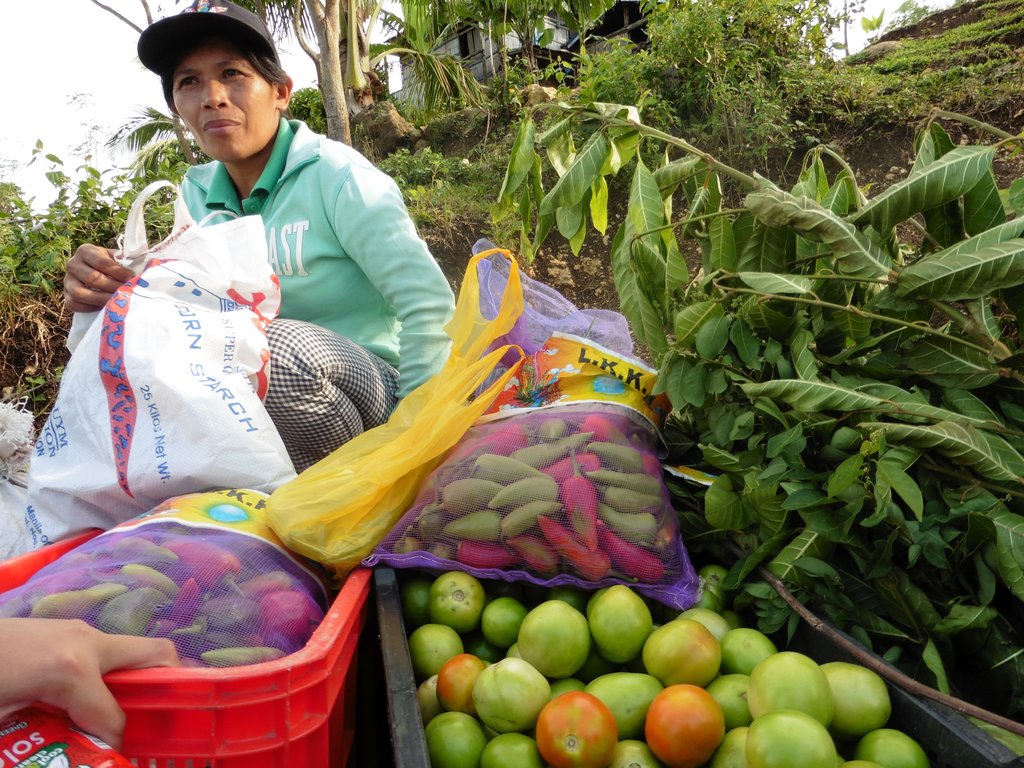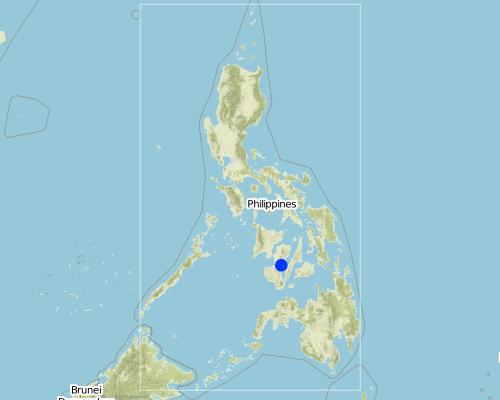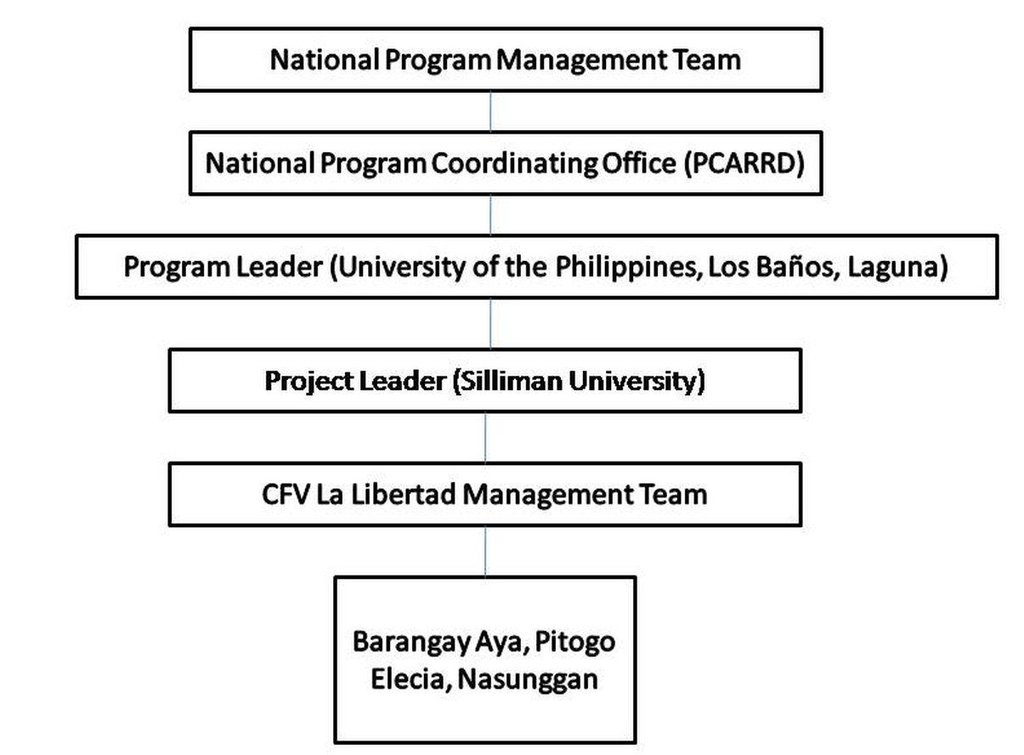Conservation Farming Village [Philippines]
- Création :
- Mise à jour :
- Compilateur : Philippine Overview of Conservation Approaches and Technologies
- Rédacteur : –
- Examinateur : Ursula Gaemperli
approaches_1969 - Philippines
Voir les sections
Développer tout Réduire tout1. Informations générales
1.2 Coordonnées des personnes-ressources et des institutions impliquées dans l'évaluation et la documentation de l'Approche
Personne(s) ressource(s) clé(s)
Spécialiste GDT:
Spécialiste GDT:
Cruz Dr. Rex Victor O.
+63 49 536 5314
rexcruz@yahoo.com
Environmental Forestry Programme of the College of Forestry and Natural Resources (CFNR ), University of the Philippines Los Baños
College, Laguna 4031
Philippines
Nom du projet qui a facilité la documentation/ l'évaluation de l'Approche (si pertinent)
Decision Support for Mainstreaming and Scaling out Sustainable Land Management (GEF-FAO / DS-SLM)Nom du ou des institutions qui ont facilité la documentation/ l'évaluation de l'Approche (si pertinent)
Department of Agriculture-Region VIII (DA-8) - PhilippinesNom du ou des institutions qui ont facilité la documentation/ l'évaluation de l'Approche (si pertinent)
Farming Systems and Soil Resources Institute, University of the Philippines Los (Farming Systems and Soil Resources Institute, University of the Philippines Los) - PhilippinesNom du ou des institutions qui ont facilité la documentation/ l'évaluation de l'Approche (si pertinent)
Municipality of La Libertad, Negros Oriental, Philippines (Municipality of La Libertad) - PhilippinesNom du ou des institutions qui ont facilité la documentation/ l'évaluation de l'Approche (si pertinent)
Silliman University, Dumaguete, Philippines (Silliman University) - Philippines1.3 Conditions relatives à l'utilisation par WOCAT des données documentées
Quand les données ont-elles été compilées (sur le terrain)?
06/08/2015
Le compilateur et la(les) personne(s) ressource(s) acceptent les conditions relatives à l'utilisation par WOCAT des données documentées:
Oui
1.4 Références au(x) questionnaire(s) sur les Technologies de GDT
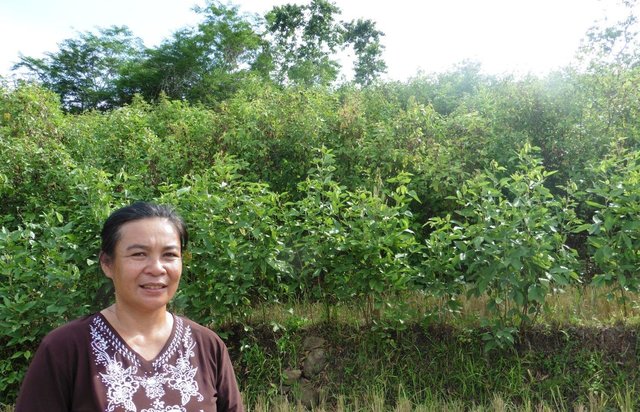
Seed Production of Multipurpose Shrubs/Legumes [Philippines]
Seed production of multipurpose shrubs and legumes, a soil conservation practice in sloping areas wherein flemingia (Flemingia macrophylla) and Indigofera (Indigofera tinctoria) are densely planted along contours.
- Compilateur : Philippine Overview of Conservation Approaches and Technologies
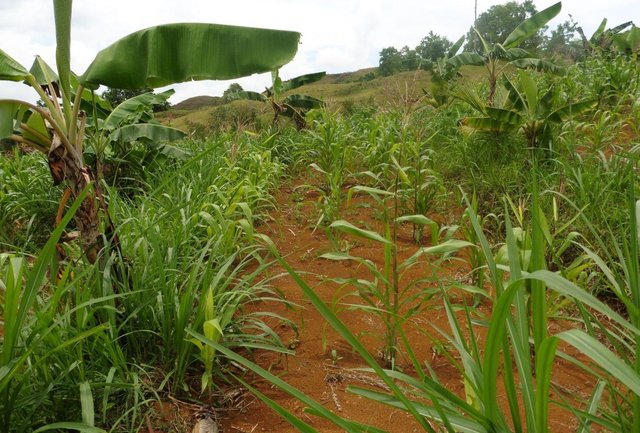
Contour Farming using hedgerows [Philippines]
Contour farming is a technology practiced in sloping areas in which hedgerows are established along the contours and other annual/cash crops are grown in the alleys between the hedges.
- Compilateur : Philippine Overview of Conservation Approaches and Technologies
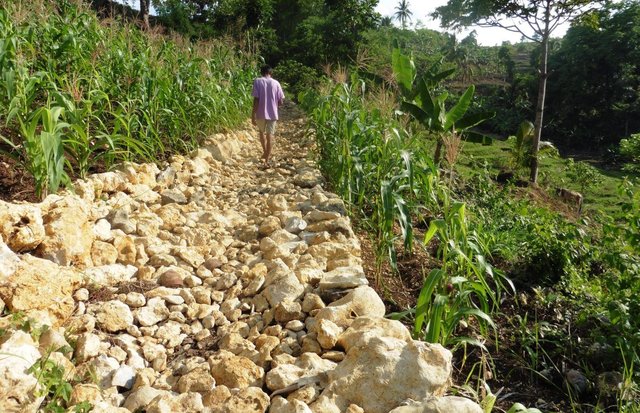
Rockwall Terracing [Philippines]
Rockwall terracing refers to the piling of stones or rocks along contour lines to reduce soil erosion in hilly areas.
- Compilateur : Philippine Overview of Conservation Approaches and Technologies
2. Description de l'Approche de GDT
2.1 Courte description de l'Approche
A modality in mobilizing resources for sustainable upland development which utilizes a basket of strategies, technologies, and interventions to catalyze the widespread transformation of traditional upland farming systems into resilient and sustainable upland production systems.
2.2 Description détaillée de l'Approche
Description détaillée de l'Approche:
The objectives of Conservation Farming Village (CFV) are the following: to enhance farmers' adoption of sloping land management technologies through Science and Technology-based farming; to capacitate key groups and stakeholders in the community to better manage fragile upland resources; to conduct sustainability exercises to ensure sustainability of upland community development; to establish linkages among research-extension agencies and organizations for capacity building; and to provide support systems for the conservation farming communities.
The methods involved in the approach include capacitating upland farmers for sustainable development; strong Local Government Unit (LGU) support system; and establishing collaborative linkages and partnership as a tool for an enhanced support system.
The project of CFV in La Libertad, Negros Oriental was initiated in 2009. The first stage in the implementation of the approach is program orientation followed by community profiling. Then, Community Organizing or People's Organization strengthening. After that, technical trainings, barangay development council and municipal development council meetings were conducted to capacitate the farmers. Farm establishment was done through 'bayanihan' or group volunteerism, and lastly, farmers were encouraged to participate in the CFV.
The National Program Coordinating Office, Philippine Council for Agriculture, Aquatic and Natural Resources Research and Development (PCAARRD) and academic institutions (University of the Philippines Los Baños, Silliman University) provided technical support in the conceptualization and implementation of CFV. The LGU of La Libertad conducted the following : (1) capacity building for farmer volunteers and adopters; (2) assist in the establishment of science and technology-based conservation model farms; (3) incorporate CFV activities in the LGU Annual Investment Plan; and (4) provision of livelihood and support mechanisms to farmers.The implementation of the CFV project became a focal point of convergence of relevant and related activities being undertaken in the upland communities of La Libertad by Non-Government Organizations (NGOs), Government Offices (GOs) and other institutions.Through this approach, the farmers have made linkage with other service providers that enhanced the farmers' access to examine other technology options, livelihood opportunities, credit and financing source, and others that may help the farmers.
2.3 Photos de l'approche
2.5 Pays/ région/ lieux où l'Approche a été appliquée
Pays:
Philippines
Région/ Etat/ Province:
Negros Oriental
Autres spécifications du lieu :
La Libertad
Map
×2.6 Dates de début et de fin de l'Approche
Indiquez l'année de démarrage:
2009
2.7 Type d'Approche
- fondé sur un projet/ programme
2.8 Principaux objectifs de l'Approche
The CFV addresses the development, application, and validation of integrated farming systems in which holistic technology transfer and emphasis on sustainable development dimensions - environmental, economic, social - are the major driving forces for economic and environmental security.
2.9 Conditions favorisant ou entravant la mise en œuvre de la(des) Technologie(s) appliquée(s) sous l'Approche
normes et valeurs sociales/ culturelles/ religieuses
- favorise
Selection of farmer volunteers to be included in the CFV program and establishment of model farms. Government executives were invited to participate in farmers' field day in remote upland villages to show to the farmers their intention to support the program.
disponibilité/ accès aux ressources et services financiers
- favorise
Incorporation of the CFV program in the Annual Investment Plan (AIP) of the LGU of La Libertad, Negros Oriental
cadre institutionnel
- favorise
Farmers' organizations were organized and strengthened by mobilizing the 'Dagyaw Team' or Volunteers Group for the establishment of CFV model farms.
connaissances sur la GDT, accès aux supports techniques
- favorise
Provided series of technical training on the concepts and practices in CFV to the Barangay Development Councils (BDCs), Farmer Association, Municipal Development Councils (MDCs) and other stakeholders to enhance awareness on land degradation in the uplands and other environmental issues.
3. Participation et rôles des parties prenantes impliquées dans l'Approche
3.1 Parties prenantes impliquées dans l'Approche et rôles
- exploitants locaux des terres / communautés locales
Land user from the upland barangay
- Spécialistes de la GDT/ conseillers agricoles
LGU of La Libertad
Si plusieurs parties prenantes sont impliquées, indiquez l'organisme chef de file ou l'institution responsable:
Local land users
3.2 Participation des exploitants locaux des terres/ communautés locales aux différentes phases de l'Approche
| Participation des exploitants locaux des terres/ communautés locales | Spécifiez qui était impliqué et décrivez les activités | |
|---|---|---|
| initiation/ motivation | passive | Ten model farms were selected from CFV barangays. |
| planification | interactive | Participation in meetings, sharing inputs. |
| mise en œuvre | interactive | Model farm establishment and maintenance, Farmer volunteers serve as local extension agents to fellow farmers. |
| suivi/ évaluation | interactive | Participation in consultation meetings, farm record keeping. |
| research |
3.3 Diagramme/ organigramme (si disponible)
Description:
Organizational structure in the implementation of CFV
Auteur:
Dr. Rex Victor O. Cruz, University of the Philippines, Los Baños
3.4 Prises de décision pour la sélection de la Technologie/ des Technologies
Indiquez qui a décidé de la sélection de la Technologie/ des Technologies à mettre en œuvre:
- principalement les exploitants des terres soutenus par des spécialistes de la GDT
Expliquez:
Technical staff from the local government of La Libertad were assigned to the different barangay of the CFV to teach and guide land users on technologies that could be used in the farm (e.g contouring) and land users will decide what crops or hedgerows to be planted.
Spécifiez sur quelle base ont été prises les décisions:
- expériences et opinions personnelles (non documentées)
4. Soutien technique, renforcement des capacités et gestion des connaissances
4.1 Renforcement des capacités/ formation
Une formation a-t-elle été dispensée aux exploitants des terres/ autres parties prenantes?
Oui
Spécifiez qui a été formé:
- exploitants des terres
- personnels/ conseillers de terrain
Formats de la formation:
- sur le tas
- zones de démonstration
- réunions publiques
Thèmes abordés:
Conservation Farming, Sloping Land Management, Agroforestry, Climate Change , Organic Farming/Fertilizer Production, measuring rainfall and soil erosion. Trainers' training were conducted to capacitate the implementer.
4.2 Service de conseils
Les exploitants des terres ont-ils accès à un service de conseils?
Non
4.3 Renforcement des institutions (développement organisationnel)
Des institutions ont elles été mises en place ou renforcées par le biais de l'Approche?
- oui, modérément
Spécifiez à quel(s) niveau(x), ces institutions ont été renforcées ou mises en place:
- local
Précisez le type de soutien:
- renforcement des capacités/ formation
- équipement
4.4 Suivi et évaluation
Le suivi et l'évaluation font ils partie de l'Approche? :
Oui
Si oui, ce document est-il destiné à être utilisé pour le suivi et l'évaluation?
Non
4.5 Recherche
La recherche a-t-elle fait partie intégrante de l’Approche?
Oui
Spécifiez les thèmes:
- économie/ marketing
- technologie
Donnez plus de détails et indiquez qui a mené ces recherches:
Researches were conducted by PCAARRD and UPLB to evaluate the approach and technologies introduced in the area. Land users were also taught about climatic data collection such as rainfall and farm record keeping that could be used in evaluating the impacts.
5. Financement et soutien matériel externe
5.1 Budget annuel de la composante GDT de l'Approche
Si le budget annuel précis n'est pas connu, indiquez une fourchette:
- 10 000-100 000
Commentez (par ex. principales sources de financement/ principaux bailleurs de fonds):
PCAARRD and UPLB 30%, LGU of La Libertad 70%
5.2 Soutiens financiers/ matériels fournis aux exploitants des terres
Les exploitants des terres ont-ils reçu un soutien financier/ matériel pour la mise en œuvre de la Technologie/ des Technologies?
Oui
5.3 Subventions pour des intrants spécifiques (incluant la main d'œuvre)
- équipement
| Spécifiez les intrants subventionnés | Dans quelle mesure | Spécifiez les subventions |
|---|---|---|
| outils | entièrement financé | shovel, mattock, sickle and bolo |
- intrants agricoles
| Spécifiez les intrants subventionnés | Dans quelle mesure | Spécifiez les subventions |
|---|---|---|
| semences | entièrement financé | vegetable & forage seeds, coffee & cacao seedlings |
5.4 Crédits
Des crédits ont-ils été alloués à travers l'Approche pour les activités de GDT?
Non
5.5 Autres incitations ou instruments
D'autres incitations ou instruments ont-ils été utilisés pour promouvoir la mise en œuvre des Technologies de GDT?
Non
6. Analyses d'impact et conclusions
6.1 Impacts de l'Approche
Est-ce que l'Approche a aidé les exploitants des terres à mettre en œuvre et entretenir les Technologies de GDT?
- Non
- Oui, un peu
- Oui, modérément
- Oui, beaucoup
Soil and water conservation measures were introduced to the land users such as contour hedgerows of legumes that contribute in improving the quality of the soil and lessen soil erosion.
Est-ce que l'Approche a autonomisé les groupes socialement et économiquement défavorisés?
- Non
- Oui, un peu
- Oui, modérément
- Oui, beaucoup
The approach involved the upland farmers in the establishment of science and technology based farms. 80-90% of the farmer-volunteers and adaptors perceived that CFV led to an increase in their crop and farm yield resulting in increased income.
Est-ce que l'Approche a amélioré les questions foncières et des droits d'utilisation qui entravent la mise en œuvre des Technologies?
- Non
- Oui, un peu
- Oui, modérément
- Oui, beaucoup
Est-ce que l'Approche a conduit à améliorer la sécurité alimentaire et/ou la nutrition?
- Non
- Oui, un peu
- Oui, modérément
- Oui, beaucoup
Increase in per capita income of CFV farmer-volunteers from Php 7,973.00 in 2004 to Php 16,745.42 in 2013, representing 47.6% increase.
Did other land users / projects adopt the Approach?
- Non
- Oui, un peu
- Oui, modérément
- Oui, beaucoup
Eight barangays with fifteen model farms adopted the CFV approach in La Libertad, Negros Oriental. The program was also replicated by other neighboring municipality.
Did the Approach lead to improved livelihoods / human well-being?
- Non
- Oui, un peu
- Oui, modérément
- Oui, beaucoup
Before, land users planted rice and corn only but after the program was introduced, they are now planting high value crops that provide higher income to them.
6.2 Principale motivation des exploitants des terres pour mettre en œuvre la GDT
- augmenter la production
- augmenter la rentabilité/ bénéfice, rapport coûts-bénéfices
- Trainings and study tours (Lakbay-Aral)
6.3 Durabilité des activités de l'Approche
Les exploitants des terres peuvent-ils poursuivre ce qui a été mis en œuvre par le biais de l'Approche (sans soutien extérieur)?
- oui
Si oui, décrivez de quelle manière:
The land users were capacitated by the LGU through trainings, cross visits so that they can manage their farms and to share the knowledge with neighboring farmers.
6.4 Points forts/ avantages de l'Approche
| Points forts/ avantages/ possibilités du point de vue de l'exploitant des terres |
|---|
| Marketing support system with the establishment of barangay trading post in the CFV sites,support for the operations of the two livestock auction markets at two barangays, transport of farm products from CFV sites to Poblacion in time for the market day every Thursday and linkage with OURFOOD Program (AFOS) based in Cebu City for the marketing of organically-grown high value crops. |
| Points forts/ avantages/ possibilités du point de vue du compilateur ou d'une autre personne ressource clé |
|---|
| Strong LGU support wherein they are the forefront for the present and the future of the CFV programs or any development program.They are the only permanent local institution that could deliver services and support to development initiatives. |
6.5 Faiblesses/ inconvénients de l'Approche et moyens de les surmonter
| Faiblesses/ inconvénients/ risques du point de vue du compilateur ou d'une autre personne ressource clé | Comment peuvent-ils être surmontés? |
|---|---|
| No clear zoning and proper delineation for the CFV and reforestation areas. | There should be a clear zoning through policy and ordinance by the national and local government to sustain and preserve the CFV sites. |
7. Références et liens
7.1 Méthodes/ sources d'information
- visites de terrain, enquêtes sur le terrain
- interviews/entretiens avec les exploitants des terres
Liens et modules
Développer tout Réduire toutLiens

Seed Production of Multipurpose Shrubs/Legumes [Philippines]
Seed production of multipurpose shrubs and legumes, a soil conservation practice in sloping areas wherein flemingia (Flemingia macrophylla) and Indigofera (Indigofera tinctoria) are densely planted along contours.
- Compilateur : Philippine Overview of Conservation Approaches and Technologies

Contour Farming using hedgerows [Philippines]
Contour farming is a technology practiced in sloping areas in which hedgerows are established along the contours and other annual/cash crops are grown in the alleys between the hedges.
- Compilateur : Philippine Overview of Conservation Approaches and Technologies

Rockwall Terracing [Philippines]
Rockwall terracing refers to the piling of stones or rocks along contour lines to reduce soil erosion in hilly areas.
- Compilateur : Philippine Overview of Conservation Approaches and Technologies
Modules
Aucun module trouvé


